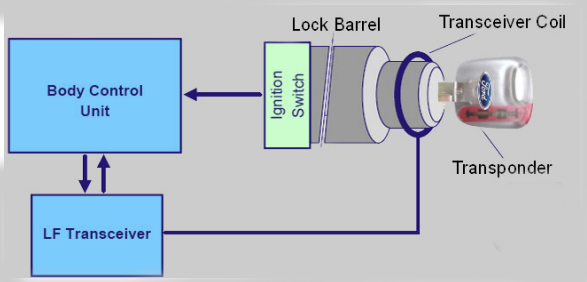I'm confused
Are you saying the key sends out a signal?
in order for it to do that would it not have to have a battery in it
If so it will only last so long before the battery goes dead
Then what?
Don
There are transponders that use batteries. But this is not the case of keys for your vehicle (or in this case your Spyder).
What motor vehicle manufacturers are using is a Magnetic Coupled Transponder system. Magnetic Coupled Transponder systems are passive in nature. This means they do not require constant electricity and thus do not need a power source of their own. They operate in the frequency range area of 125KHz. Since Magnetic Coupled Transponders do not have their own power source they are very limited to range of communication and generally operate in the range of 1cm to 15cm (or 0.393701 of an inch to 5.9 inches). Since this is a radio frequency it can penetrate materials that would make the transponder not directly visible, such as the plastic or rubber in a key fob.
The keys must be "programmed" to match your vehicles ignition system because the ignition system is expecting to receive a very specific response from the key when the ignition is turned on. That is why if you loose your keys, it will be necessary to replace components in your Spyder and program the Spyder again. VERY EXPENSIVE!
If you loose one key, but have one remaining, a second key can be made because the information stored in the key transponder can be read. However, a Spyder dealer will want to reprogram the entire system, i.e. ignition system and key with new codes. If a Spyder dealer just cloned your remaining key, then anyone who came into possession of your lost key could start your Spyder and drive away.
Cloning IS NOT what a Spyder dealer does. He actually reprograms the entire system so that any lost key WILL NOT WORK! In order to reprogram the entire system, the Spyder dealer MUST HAVE a working key to accomplish the task.
If you are on a long trip and do not have access to your remaining key and loose the one you have - you are in for a very expensive repair since the dealer will need to replace the electronics in your Spyder. Remember, we are trying to foil thieves, so making it easy to match a key to the electronics of your Spyder defeats the purpose of having a transponder key. The dealer NEEDS a key from your Spyder to work with the existing electronics built-in to your Spyder. Loose both keys and it will cost you $1000 plus to get back on the road.
If you read my earlier posts - I purchased 2 cloned keys. I now have a total of 4 keys. I was comfortable cloning my keys because I had not actually lost one. Even if you lost one key, you may still be okay with just acquiring a cloned key. For example, if you dropped one key in the ocean or in the Grand Canyon, you probably don't have to worry that someone will find it and actually use it to steal your Spyder. If you don't know where you lost your key, you may feel uncomfortable and want the dealer to reprogram your system so the old key won't work.
You are probably using multiple transponders today and may not even know it. People who have their pets "chipped" so it can be identified if the pet is lost have a transponder. You are not having to change a battery in your pet, right? Nope, that is because it uses a similar system of using radio frequencies to send a faint signal to a receiver. People who drive cars that allow them to bypass toll booths at bridges and roads have transponders. If you can just wave your credit card instead of swiping it, you have a transponder.
This also means when you walk around with something in your pocket or on your person with a transponder, you can be tracked. Your smart phone is constantly allowing you to be tracked.
Some transponders require batteries and some don't. Your Spyder key doesn't.
P.S. If you choose to rob a bank, remove everything from your person, credit cards, phones, key fobs, etc. or else you could be tracked!
A transponder is a benign electronic device implanted in the head of a key which remains dormant until awakened by energy derived from its close proximity to an induction coil/antenna at the threshold of a vehicle’s ignition lock. When a transponder becomes energized by the ignition lock being turned ON, it transmits a unique alpha/numeric identity code back to the antenna coil and the on-board computer - for comparison with values stored in the computer’s memory. If the RF transmission from the transponder is an exact match then the engine can be started.

